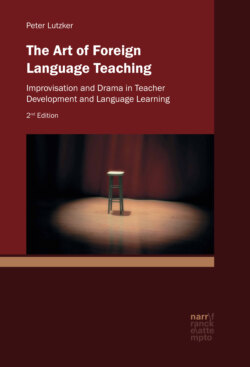Читать книгу The Art of Foreign Language Teaching - Peter Lutzker - Страница 30
На сайте Литреса книга снята с продажи.
1.3.8 Teaching as Improvisational Performance – R. K. Sawyer
ОглавлениеIn a series of articles in which he has critically evaluated the widespread propagation of scripted teaching methods, R. Keith Sawyer has offered a vision of teaching as a form of collaborative improvisation in which the teacher and pupils co-create classroom discourse.135 Arguing that research has demonstrated that one of the defining characteristics of outstanding teaching is the ability to react flexibly to the dynamics of classroom interaction, he has criticized recent formalistic approaches to teaching in which this element of teachers and pupils improvising together in the classroom is discounted.
In the context of explaining his understanding of collaborative learning, he draws clear parallels with the methods of improvisational theatre work:
In improvisational theatre, a group of actors creates a performance without using a script. Some groups specialize in short skits only a few minutes long, and others specialize in fully improvised one- or two-act plays of an hour or more. These performances emerge from unpredictable and unscripted dialogue, on stage and in front of an audience. In a similar way, an effective classroom discussion emerges from classroom discourse, and is not scripted by the lesson play or by the teacher’s predetermined agenda.136
In his discussion of the potential significance of such improvised classroom discussions for learning, Sawyer draws on constructivist thinking in which learning is viewed as a creative and improvisation process, co-created by teacher and the pupil. Moreover, he establishes connections to recent socio-cultural theory in which the overriding significance of the activities and processes within the entire group are emphasized. In the end, he draws conclusions as to what this could mean for teaching:
The socio-cultural perspective implies that the entire classroom is improvising together; and it holds that the most effective learning results when the classroom proceeds in an open, improvisational fashion, as children are allowed to experiment, interact, and participate in the collaborative construction of their own knowledge. In improvisational teaching, learning is a shared social activity, and is collectively managed by all participants, not only the teacher.137
In discussing the necessary attributes of the teacher as improviser, Sawyer stresses the importance of a high degree of subject knowledge in order to be able to respond spontaneously and creatively, and contrasts this broad knowledge to the narrow range of materials offered in pre-planned lesson scripts. He then describes what he considers the decisive skill of managing a group improvisation, requiring a fine sensitivity to finding the balance between the need to maintain pre-existing structures and leaving enough openness for collaborative learning to emerge.138 After elucidating the connections which he sees between the collaborative skills required in the classroom and what is developed through improvisational theatre, he proposes that teachers be trained in those techniques that are taught to aspiring improvisational actors. Arguing that there is already a body of expertise in these areas, he sees a wide range of possibilities for teachers learning from what has already been developed and published for the training of actors.139 He notes that there have been in recent years a series of summer programs and workshops based on different improvisational exercises and mentions the positive program assessment which these organizations have received from participants.140 He argues for the systematic development of such programs in order to determine the most effective manner of integrating such work into teacher education.
Sawyer has succeeded in drawing together research from different fields to construct a basis for his arguments. In his proposal that teachers practice those kinds of exercises which aspiring improvisational actors use in order to concretely develop these skills, he has introduced a clear perspective into teacher training. There are a number of connections that can be drawn between many of his ideas and the conceptual basis of the research study which will be developed in the ensuing chapters, although these concepts were developed independently of each other. The open questions which he has posed regarding the need to find the best ways to incorporate these skills into teacher training, along with his call for empirical research to be conducted in this field, closely match the intentions of the present study of the clowning courses.
